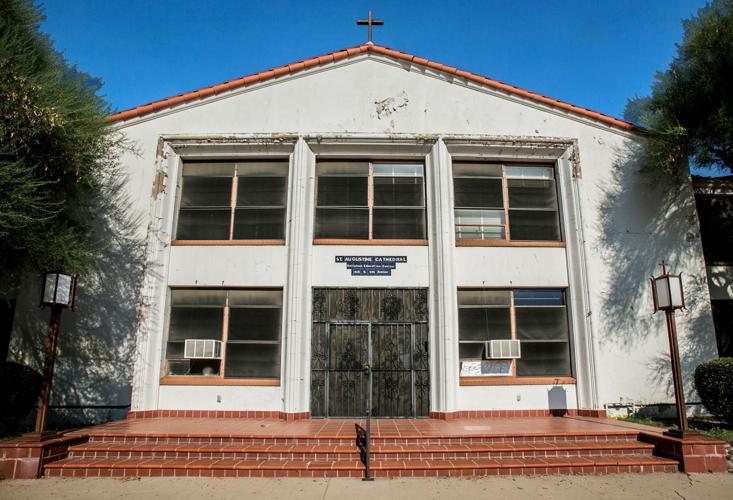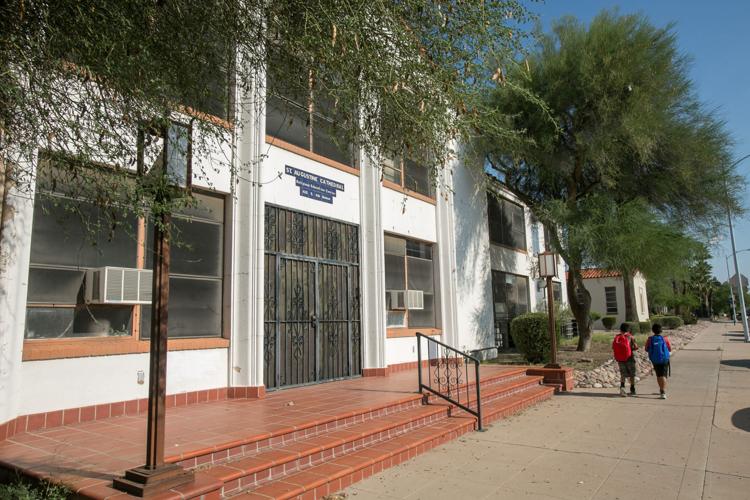The memories were flowing for a small group of friends about the old school, All Saints Catholic.
They remembered the nuns, those in the black and white habits, followed by the nuns dressed in blue and white. They also remembered the lay teachers, a couple of whom, believe it or not, were stricter than the nuns.
They remembered the classrooms where they were taught and the cloakroom where other lessons were learned. They remembered the asphalt playground where scrapes were earned as badges and they recalled making that rare entrance through the door into the mysterious convent next to the school.
And they remembered their classmates, Mexican, Anglo and black kids from the nearby downtown barrios and other parts of the city who all gathered together in the classrooms of the two-floor rectangular building on South Sixth Avenue.
“Today I realize what a privilege it was,” said Annette Anaya, who lives in Queen Creek near Phoenix.
For Richard Elías, the schooling was a very good deal. “I think our lives got better,” said the Pima County supervisor.
I nodded my head in agreement. I’m an alum of the school, as are my three siblings.
Recently I joined five former All Saints students to hear and talk about the school, common experiences, individual memories. The group is planning a reunion for all former All Saints’ students at the school on Sept. 16.
Along with Dianne Corral Castillo, Felicia Frontain and Ann Charles, Anaya and Elías are planning the reunion. With the exception of Charles, who attended for several years, the other four were part of the school’s last class, which graduated from the eighth grade in 1972, the year the school closed.
For us, and I suspect many other All Saints students, the school provided a normal grade-school experience in many ways. The morning bell rang, we lined up with our classes and walked to our classrooms for our daily instruction. We had recess, lunch and occasional visits to the principal’s office.
However, being in a Catholic school, we also had a much different experience than our neighborhood friends who went to public schools. We attended Mass once a week or sometimes more often if there was a religious holiday, and we wore uniforms (plaid blue skirts and white blouses for the girls, navy blue pants and light blue shirts for the boys). We wrote “JMJ” (Jesus, Mary, Joseph) on our assignments and we said prayers every day, or at least we pretended.
We had a shared experience and, contrary to popular folklore about Catholic schools, we don’t recall that the nuns dished out much corporal punishment. Not to say they weren’t strict; in individual cases some nuns were just plain mean. But we viewed many of the nuns with respect and often we formed strong bonds with them.
“The nuns were exceptional,” said Frontain, who works at the University of Arizona.
We remembered some of them: Sister Bernice, Sister Evelyn, Sister Ann Elizabeth, Sister Kathleen Marie and Sister Daniel Joseph.
As the ’60s came to a close, amidst swirling national changes in attitudes and politics, the nuns scaled back their religious clothing and the hemlines came up. They revealed themselves more as human beings, said the group.
The school wasn’t immune to social changes.
All Saints Church, at 410 S. Sixth Ave., was created for racial reasons. St. Augustine Cathedral was only a couple of blocks away but it was considered the “Mexican” church. The growing number of English-speaking Catholics wanted their own church. As a December 1912 headline in the Arizona Daily Star put it: “House of Worship for English Speaking Catholics.”
By the the mid-1940s, All Saints School, across the street at 415 S. Sixth Ave., opened. Nearby Cathedral school was for Mexican-Americans, blacks and anyone else who didn’t fit All Saints’ mold.
By the 1960s, All Saints School had become integrated. In 1966, All Saints Church closed and merged with the Cathedral and the following year Cathedral School closed and its students joined All Saints and the school was renamed. About the same time, the all-girls Immaculate Heart Academy, across the street at East 15th Street and South Sixth Avenue, closed and many of the girls came to All Saints.
As the student population changed, we had more lay teachers in the classrooms. And in 1972, Cathedral School closed due to gradual loss of nuns and because of higher operating costs. Subsequently the building was used for religious education classes but those, too, ended. Earlier this year the Cathedral Parish sold the 15,736-square-foot building to Peach Properties, which is in the process of converting it into residential units.
The reunion group shared a sense of loss and sadness when the school closed. We all understand that change comes, people and buildings come and go. But we felt special at All Saints.
Castillo, who now lives in Chandler, said All Saints gave her comfort. “We were a family there. Everybody knew everybody.”





